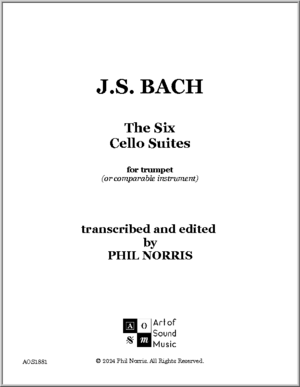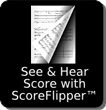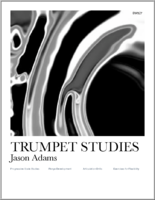The Six Bach Cello Suites adapted for trumpet (or comparable treble clef instrument)
| Arranger | Norris, Phil |
|---|---|
| Composer | Bach, Johann Sebastian |
| Duration | 70 |
| Ensemble | Trumpet |
| Genre | Classical |
| Grade | 5 |
| Model Number | AOS1881 |
| Category | Unaccompanied Trumpet |
For unaccompanied trumpet or comparable treble clef instrument. Edited by Phil Norris.
Table of Contents:
1. Suite 1 BWV 1007
2. Suite 2 BWV 1008
3. Suite 3 BWV 1009
4. Suite 4 BWV 1010
5. Suite 5 BWV 1011
6. Suite 6 BWV 1012
71 Pages
The editor writes:
The music of J.S. Bach, both instrumental and vocal/choral, has proven rich material for transcription for a over two hundred fifty years now. His music is both masterful and instructive in understanding musical expression and meaning. This work, yet another transcription, is meant to provide further musical experience as well as a rigorous workout for the player.
The editing of the material is my own: transposition of keys suitable to the trumpet, articulations, phrasing, and dynamics, that I trust are in the spirit of Baroque performance and address the needs of the player who might make use of these transcriptions. Editing was based on editions of the suites by J.J.F. Dotzauer (Breitkopf & Härtel) and Hugo Becker (C.F. Peters) as well as recordings by Yo-Yo Ma and Pablo Casals. Every effort was made to capture the cello’s phrasing and style yet within the context of trumpet playing.
The printed repeat signs are omitted from this transcription. The endurance required to play each suite entirely with the repeats is gargantuan and will likely prove too much for most players, but should you wish to repeat as in the original score, the double bar marking indicates where those repeats take place. A few of the short, repeated sections are included. In view of the endurance demands of these pieces, I recommend playing with a light and quieter style than you might usually interpret the printed dynamics, none of which are in the original score. Suggested breath marks are occasionally inserted in the score, but each player may add to or ignore those marks as needed or desired within the natural phrasing of the music.
I also encourage, if you wish, adding ornaments not included in this transcription as appropriate to and consistent with Baroque performance practice, such as mordents, passing tones, or light, short trills. Players are encouraged to approach these pieces with a flexibility of tempo and pacing which I believe will add an expressive element to playing them. To play with strict tempo and timing will render them mechanical and uninteresting: a mere technical display. As models, I highly recommend listening to notable recordings of these works by respected cellists, not the least of which is Pablo Casals (who I understand played these daily to challenge his musicality and technique), or others including: YoY o Ma, János Starker, or Mstislav Rostropovich. Regardless of the model you choose, aim to play each piece with musical expression in a manner fitting to the instrument you play.









